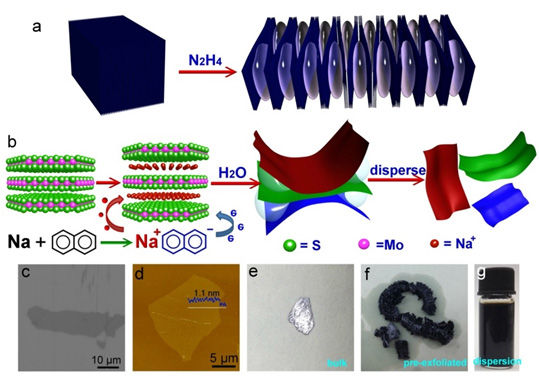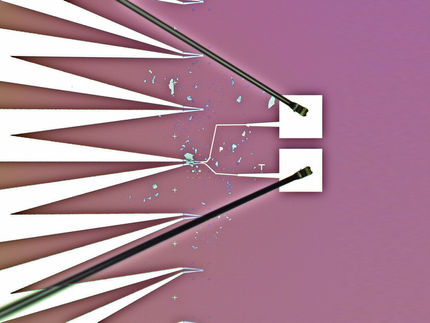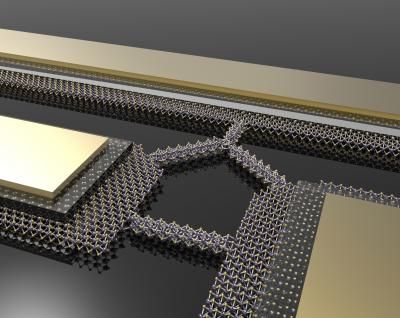Novel exfoliation method developed
A team of scientists from the National University of Singapore (NUS) has successfully developed a method to chemically exfoliate molybdenum disulfide crystals, a class of chalcogenide compounds, into high quality monolayer flakes, with higher yield and larger flake size than current methods. The exfoliated flakes can be made into a printable solution, which can be applied in printable photonics and electronics.

Schematic of pre-exfoliation, intercalation and exfoliation processes
National University of Singapore
This breakthrough, led by Professor Loh Kian Ping, who heads the Department of Chemistry at the NUS Faculty of Science, and is also a principal investigator with the Graphene Research Centre at the Faculty, has generic applicability to other two-dimensional chalcogenides, such as tungsten diselenide and titanium disulfide, and results in high yield exfoliation for all of these two-dimensional materials.
The NUS team collaborated with scientists from the Ulsan National Institute of Science and Technology in Korea, and the findings were first published online in scientific journal Nature Communications.
Demand for high efficiency exfoliation method
Transition metal dichalcogenides, formed by a combination of chalcogens, such as sulphur or selenium, and transition metals, such as molybdenum or tungsten, have recently attracted great attention as the next generation of two-dimensional materials due to their unique electronic and optical properties, for applications in optoelectronic devices such as thin film solars, photodetectors flexible logic circuits and sensors.
However, current processes of producing printable single layer chalcogenides take a long time and the yield is poor. The flakes produced are of submicron sizes, which make it challenging to isolate a single sheet for making electronic devices.
As most applications require clean and large-sized flakes, this pinpoints a clear need to explore new ways to make high quality single-layer transition metal dichalcogenides with high yield.
Breakthrough in production
To address the production bottleneck, the NUS team explored the metal adducts of naphthalene. They prepared naphthalenide adducts of lithium, sodium and potassium, and compared the exfoliation efficiency and quality of molybdenum disulfide generated. The processing steps are detailed in the Annex.
Using a two-step expansion and intercalation method, the researchers were able to produce high quality single-layer molybdenum disulfide sheets with unprecedentedly large flake size.
The researchers also demonstrated that the exfoliated molybdenum disulfide flakes can be made into a printable solution, and wafer-size films can be printed, as the good dispersion and high viscosity of the flakes render it highly suitable for inkjet printing.
In a comparative analysis, Dr Zheng Jian, the first author of the paper, who is also a Research Fellow with the Department of Chemistry at NUS Faculty of Science, found that the alkali metal naphthalenide intercalation method applied possesses significant advantages in comparison to the conventional method.
Commenting on the significance of the findings, Prof Loh said, “At present, there is a bottleneck in the development of solution-processed two dimensional chalcogenides. Our team has developed an alternative exfoliating agent using the organic salts of naphthalene and this new method is more efficient than previous solution-based methods. It can also be applied to other classes of two-dimensional chalcogenides.”
“Considering the versatility of this method, it may be adopted as the new benchmark in exfoliation chemistry of two-dimensional chalcogenides,” he added.
Further research into printable devices
The fast growing field of printed photonics, electronics and optoelectronics demands high material quality, precise material deposition, and application-specific optical, electrical, chemical, and mechanical properties.
To further their research and to cater to the industry, Prof Loh and his team will be looking at developing inks based on different types of two-dimensional chalcogenides exfoliated by their novel method so as to produce printable optoelectronic devices. They will also be testing the optical non-linear properties of the flakes they have produced.
Other news from the department science
These products might interest you
Most read news
More news from our other portals
See the theme worlds for related content
Topic world Sensor technology
Sensor technology has revolutionized the chemical industry by providing accurate, timely and reliable data across a wide range of processes. From monitoring critical parameters in production lines to early detection of potential malfunctions or hazards, sensors are the silent sentinels that ensure quality, efficiency and safety.

Topic world Sensor technology
Sensor technology has revolutionized the chemical industry by providing accurate, timely and reliable data across a wide range of processes. From monitoring critical parameters in production lines to early detection of potential malfunctions or hazards, sensors are the silent sentinels that ensure quality, efficiency and safety.

































































